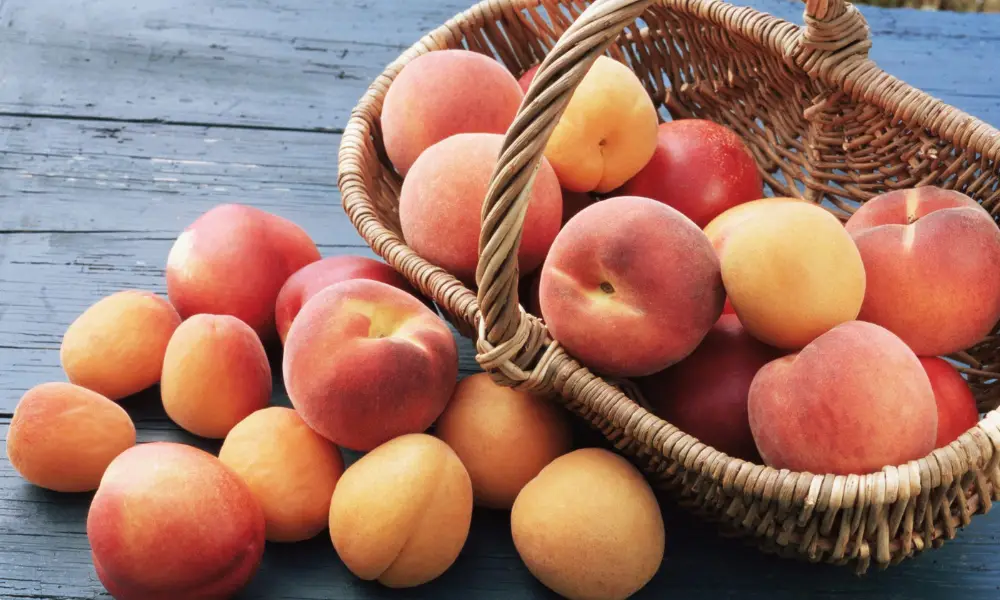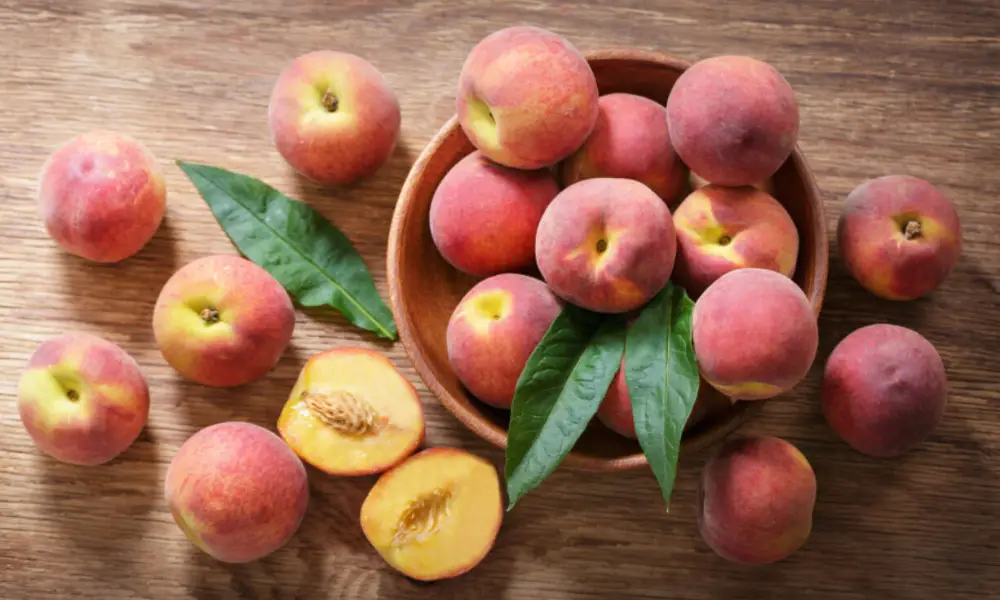A type of stone fruit known as a peach has fuzzy skin that might be yellow, orange, or soft red in color. The peach’s center is comprised of an inedible pit and is encircled by sweet, luscious yellow flesh. Since peaches are in season in the United States from May through September, peaches are a common ingredient in summer delicacies including peach cobbler, peach pie, peach ice cream, and peach jam.
Peaches can be stored for a long time if they are stored correctly. The longevity of peaches depends on how much bruising they experience. Using an airtight container, a plastic bag, or a baking sheet can help keep them fresh. Here are some tips to help you store peaches safely.

How to Store Fresh Peaches
How to Keep Peaches Safe
Since oxidation turns cut peaches brown and entire peaches overripen as they release more and more ethylene gas, proper storage is crucial to keeping peaches fresh. Use one of these six storage techniques to lengthen the shelf life of your peaches:
Apply lemon juice first. Lemon juice can be used to keep peaches from fading, just like it can with apples, potatoes, and avocados. You can either immediately apply lemon juice to the fruit’s flesh or soak chopped peaches in a solution of lemon juice and cold water. Fruit-tainting enzymes called polyphenol oxidases are rendered inactive by the acid in lemon juice.
The peaches should be blanched before freezing. Before you start blanching peaches, make an “X” on the bottom of each one. Fresh, entire peaches should be carefully inserted into boiling water for 30 to 60 seconds. Then immediately place the peaches in a dish of ice water. Peaches should be peeled before freezing whole or in slices in a freezer bag. Alternately, arrange the slices on a baking sheet in a single layer and freeze them. You can move the peaches to a plastic bag or another container once they are completely frozen.
After thawing, frozen peaches absorb moisture and become mushy, although many peach recipes benefit from this. Peaches can be frozen and later used in ice cream, jam, or smoothies.
Place cut peaches in an airtight container and refrigerate. Ripe peaches should be cut into cubes or slices and kept in the refrigerator for up to five days. The peaches can’t ripen anymore due to the chilly air, and they can’t rot due to the airtight container.
In a paper bag, ripe peaches. To ripen peaches more rapidly, keep them in a brown paper bag on the kitchen counter (and at room temperature). Use the peaches straight immediately, freeze them, put them in the refrigerator in an airtight container, or purée them to prevent them from going bad.
Cover slices of peach in sugar syrup. Sliced peaches can be canned in sugar syrup to be kept for up to a year and used afterward. Get a canning jar or other glass jar with an airtight lid, make a sugar syrup with equal parts granulated sugar and water, and store the syrup in the jar.
Sliced peaches should be added to the jar, then top it over with the sugar syrup. These peaches taste well in jams, sweets, and fruit salads.
Use ascorbic acid, please. To make a diluted solution, combine ascorbic acid or powder from vitamin C supplements with water. Sliced peaches should be submerged in the mixture, leaving a small gap at the top of the jar or storage container. For preserving or storing peaches to use later in peach recipes, this technique works wonderfully.
How Do You Peel a Peach?
To quickly remove the peach skin, follow these steps:
Each Peach’s Bottom Should Be Scored
While the water is coming to a boil, use a sharp paring knife to make a small “x” in the skin at the base of each peach. You are merely cutting the skin, so keep the cuts small. Additionally, prepare a sizable bowl of ice water so you may swiftly cool the peaches after giving them a hot bath.
Peel the Peaches
Blanching peaches helps to relax the skin and makes it much easier to remove them. The peaches’ skin is torn apart by the heat, allowing the peels to fall off rather than having to be sliced away.
In the boiling water, make sure the peaches are completely submerged. Blanching for 40 seconds. If the peaches are a touch underripe, letting them soak in boiling water for a little longer will help the peel come off and enhance the flavor.
Make an ice bath for the peaches.
Using a slotted spoon, transfer the blanched peaches to the chilly water. Give them a minute to cool. After draining, pat the peaches dry.
Peaches’ Skins to Remove
You can either pluck and remove the peach’s peel with your fingers or a paring knife. After blanching, the peel really does fall off quite easily.
Peeled Peach After being peeled, this peach is prepared for pitting and slicing.
Peeled peaches taste great on their own, in cereal bowls or fruit salads, with ice cream or whipped cream, over thick Greek-style yogurt, or all by themselves.
How Can I Choose a Peach that is Just Right?
One of the few fruits that can truly ripen after being picked, as opposed to just softening and decaying, is the peach. For those who enjoy peaches, there is good news: you may purchase peaches at different stages of maturity and finish ripening them at home. Observe these signs that a peach is fully ripe:
Look
Ripe, yellow-fleshed peaches should have a golden color hidden behind their scarlet blush. The blush on the peach is simply the area where the sun hit it and is not a sign of how ripe it is. Peaches don’t want to blush where they adhere to the tree because there is little sunshine that reaches them there. There, this color is the most obvious. Less ripe peaches have a slight yellow color. Avoid eating peaches that are still green in color. You don’t want any peaches that have any bruising, scrapes, or flat areas. Avoid any peaches with wrinkled skin as well because they were probably stored in the refrigerator too long after being picked and dried out.
Smell
Most peaches ought to smell about the same as you expect them to taste. Your peach isn’t nearly ready to eat if there isn’t any aroma because there usually isn’t any taste. The flavor of some peach cultivars can be good without having a strong peach fragrance. When purchasing produce at a farmers market, find out more about the kind you’re considering.
Feel
Like all fruits, peaches ought to be substantial for their size. On the other hand, a peach’s flesh can give away a lot about how ripe it is. Place a peach in your palm, lightly round it with your fingers, then gently squeeze it to determine how hard or soft it is:
You should not pick baseball-hard peaches since they were chosen before they were fully grown and would never develop properly.
Tennis ball-shaped peaches can be taken home to mature till later in the week even though they aren’t yet edible.
When squeezed, peach with a lot of “give” can either be eaten immediately away or put out on the counter for one or two days. These peaches are perfect for baking since they maintain their structure better than softer, more mature varieties.
Soft peaches will slightly bruise when squeezed. These are now prepared for consumption.
Super-soft peaches bruise even when they are merely sitting still. Even though they’re a touch overripe, they’re still delicious and messy to eat.
A peach that is mealy was likely picked when it was either too green or too ripe, then iced and brought to room temperature. Avoid the vendor who sold you the peach in the future.
What Kinds of Pears are There?
Stone fruit of all varieties, including peaches, is a terrific seasonal summer treat. Peaches are a perennial favorite. Some of us have wonderful memories of eating incredibly juicy peaches outside as youngsters because they were so sticky (a friend of mine used to insist on her children eating them in the lake, clad in a bathing suit, for the easiest of clean-ups).
The Peach Variety Guide
The most popular type of peach in the US is one with yellow flesh. Compared to their white-flesh relatives, they taste a little bit more acidic. Look for golden peaches that are substantial for their size, pliable in your hand, and, most importantly, have a peach-like aroma when you sniff them. A yellow peach’s stem chamber should be yellow rather than green when checked. These are all indications that a peach is ripe.
White Peaches
Due to their low acidity, white-flesh peaches, which are popular in Asia and are increasingly available in the United States, are sweeter than yellow peach cultivars. In addition, they have a smoother, more delectable feel than peaches with yellow flesh. Until you cut into or peel them, they don’t appear to be particularly different from the outside.
The majority of peaches are white or yellow, and ripeness is indicated by white or light yellow stem cavities (green indicates unripeness).
Fresh Stone Fruit
Freestone peaches are best consumed whole since the flesh does not adhere to the pit. Peaches from Clingstone are often larger and less juicy. They cook more easily and preserve well, and the flesh is simple to remove from the pit. The majority of peaches offered to retail customers are freestone varieties. From May through October, freestone peaches of various varieties are offered across the country.
Peaches from Clingstone
Clingstone peaches’ flesh adheres to their pits. Compared to freestone peaches, they are softer, sweeter, and juicier. These qualities make them well-known for canning, preserving, and baking. Commercially available canned peaches are made from clingstone peaches. One advantage of purchasing peaches at farmer’s markets is that occasionally you can find clingstones there, as opposed to most grocery stores, which exclusively carry freestones. Depending on the region, the clingstone peach season lasts from May through August.
Can We Eat Peaches After Dark?
Fruits shouldn’t be consumed after midnight because their sugars can make you feel energized. A boost in energy could create sleepiness and listlessness because your body is now shutting down. “yes.” Magnesium-rich foods are an excellent natural sleep aid for the elderly because studies have shown that they can calm the nervous system by lowering stress levels. Here are several fruits that promote sleep: Apples and peaches are rich sources of magnesium.
Conclusion
Peaches store well in plastic freezer bags. However, they lose their freshness after a few days. So, how do you save your peaches? First of all, remember that you need to blanch them for about 60 seconds in ice water. Then, cut them in half, cover them with a thin layer of syrup, and store them in the freezer for up to a year.
Fresh peaches should be stored with their stems facing downward, as this will promote ripening. Then, make sure that there is plenty of space between the peaches. If you have trouble keeping them apart, try slicing them before you store them.

